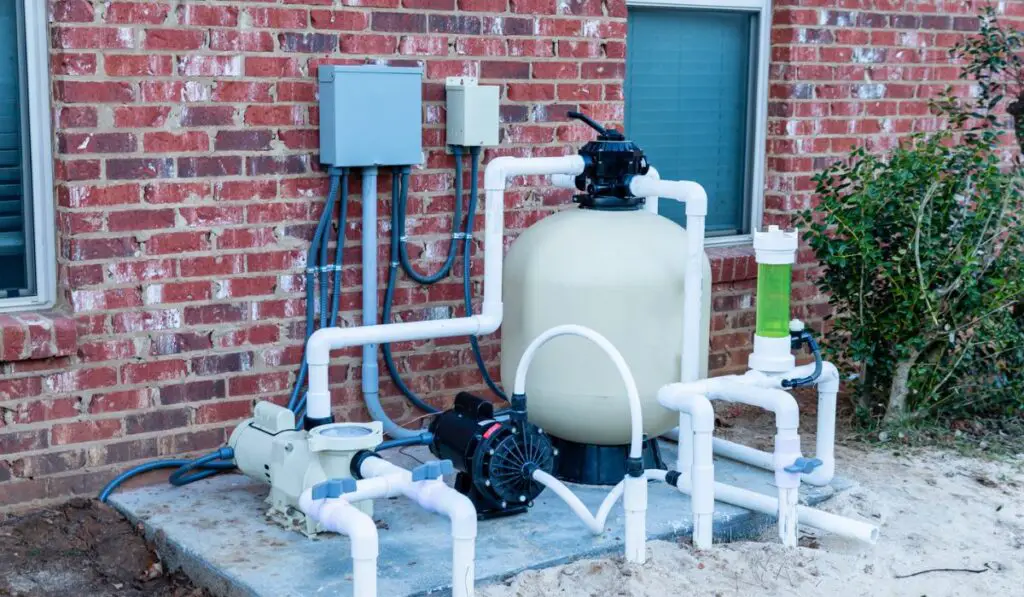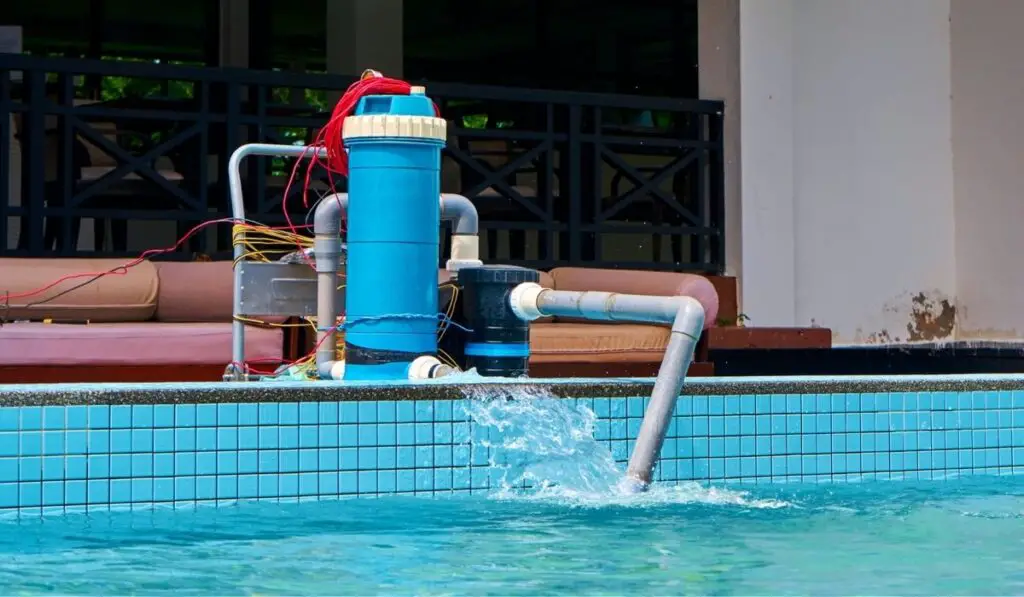The pump is the heart of every swimming pool filtration system, and residential pumps are required to have enough pumping capacity to circulate the entire pool volume every six hours! This is quite a tall order, so don’t worry if your pump malfunctions or stops working completely. Problems like these are often very easy to fix.
Your pump may not be pulling water because of a cracked or dirty filter, a clogged strainer basket, or some kind of electrical problem. Clean out the filter and strainer basket and replace any damaged components to restart circulation. If the issue still persists, call a professional.
A malfunctioning pump can really ruin a relaxing day at the pool — or even your next pool party . For this reason, it’s important to stay on top of any problems that pop up and ensure that the pump is always functioning as it should. Let’s look at how a pool pump works, why it isn’t circulating water or suctioning properly, what you can do to troubleshoot the pump, and when you should get professional help.
How Does a Pool Pump Work?

In a typical pool pump system, an electric motor powers an impeller located inside the pump’s housing. The impeller pushes the water from the different drains to the filter, which removes all the dust and small debris dirtying the pool water and then pushes it back out through the water inlets.
Just before water flows into the pump, it passes through a metal strainer that filters out any leaves or other large debris that may clog up or damage the pump.
Reasons Your Pump Isn’t Circulating Water
A cracked or dirty filter can prevent your pump from circulating water properly, even if it’s still operating. Let’s take a closer look at the reasons behind the loss of water circulation:
Strainer Obstructions
The metal strainer inside the pump prevents debris from entering the impeller and damaging it. This is basically the last-ditch filter that collects any debris that slips past the skimmer strainer.
If you don’t regularly clean the strainer, it will eventually become clogged and block the water from reaching the pump, interrupting the circulation.
In order to restore the flow of water through your pool system, you just need to clean out the strainer basket. To do so, carefully follow the instructions provided by the pump manufacturer.
Filter Neglect
A neglected pool filter might stop circulation entirely. This is normally preceded by a significant rise in filter pressure, as indicated by the gauge located at the top of the filter canister.
Remember to check the filter manufacturer’s specifications for the normal pressure range. If the pressure displayed on the gauge is too high, backwashing the filter can help solve the problem. However, it’s advisable to read the manufacturer’s instructions before doing so.
If backwashing doesn’t work, or if the filter is just too contaminated, you may need to empty the diatomaceous earth or sand filter media and replace it with a new one to restore circulation.
Why Your Pump Isn’t Suctioning Properly
An unprimed pump or a clogged filter can interrupt suction and obstruct water flow. A dirty filter or too much air in the pool system can also prevent your pump from suctioning properly.
Here are a few things you can do to solve the problem:
- If you think you have a blocked or clogged filter, check the filter gauge. If the pressure is 10psi above the normal range, clean your filter. This will help reduce pressure and reset the pump’s flow. It’s also advisable to check the impeller and pump strainer basket for debris.
- Air in the pool system usually enters through the skimmer or a leaky o-ring. Make sure the water level in your pool isn’t too low, and check the skimmer basket for leaves and debris. You might also need to fill the strainer basket with water and seal it.
- Lastly, you may need to prime the pump to restart proper circulation.
How to Troubleshoot Your Pool Pump
Most pool pump problems are easily identifiable, and you can quickly fix them yourself. Here are a few common pump problems and the steps you can take to troubleshoot and fix them:
The Pump Isn’t Switching On or Keeps Turning Off
If your pump shuts off a few minutes after you turn it on, or simply refuses to turn on, you probably have an electrical problem.
Check the breaker box for any blown fuses, and take a look at the connections as well to ensure nothing is damaged or loose. If you’re worried about causing further damage, hire a professional or a qualified electrician to take a look.
The pump motor can also overheat and automatically shut down after a few minutes because of an overloaded circuit. Make sure your pump is receiving the right voltage, and check its vents to ensure nothing is stuck in the fan.
If the motor shaft is not properly rotating, there may be something jammed in the motor. Clean the motor and try running the pump again.
If you hear a humming noise or notice that the pump is unable to run at full capacity, check the capacitor. If it’s damaged, hire a professional to replace it.
Leaky Pool Pump
If the pump is leaking, check for any cracked or damaged seals that need replacing. It’s also advisable to check the o-rings in the thread sealant, the shaft seal, and the impeller housing.
To check for damaged or leaky o-rings, move and bend the o-rings around and look for fractures or cracks. You’ll need to replace any cracked or dried-out o-rings as soon as possible.
If you don’t notice any cracks, just apply an o-ring lubricant (on Amazon). This will help create a stronger seal and increase the life of your o-rings.
The Pump Is Filled With Air
This problem can happen for several different reasons, such as:
- Faulty thread sealant
- Loose pump lid
- Air pockets inside the suction line
- Leaky valve system
- Cracked or damaged pump
- Faulty o-rings and gaskets
- Plumbing issue with the pump’s suction
Check for leaks, bad fittings, or cracks in all aforementioned components, and replace them if you notice any.
Noisy Pump
If the motor is rattling and making a lot of noise, the water flow to your pump may be obstructed. Check for air pockets and clear out any debris that’s blocking the plumbing line. On the other hand, a high-pitched screeching sound from the motor can indicate bad bearings.
Of course, it’s always best to call a professional to open up the motor and install new bearings. However, you can also try fixing the issue by softly hitting the motor with your shoe or a rubber mallet.
The Pool Pump Basket Is Empty
Your pool pump may be sucking in air or the pump basket or filter could be clogged. Here’s what you can do to fix this issue:
- Clean the pump basket and filter.
- Check the pool water level in the skimmer. If it’s too low, increase the water level.
- Check for other air pockets with the shaving cream test.
Humming Pool Pump
A humming or buzzing sound indicates that power is reaching the pool motor but is unable to start it. This could be because of a centrifugal switch, a bad capacitor, a clogged impeller, or rust buildup in the motor.
Try opening up the pump and removing any debris clogging the impeller, and then check if that solves the problem.
When to Call a Professional
If troubleshooting doesn’t work, you should call a professional who can properly diagnose and fix the problem.
It’s also advisable to consult a professional if you don’t feel comfortable troubleshooting or replacing a component yourself.
As always, make sure you assess repair costs and then decide whether repairing it is worth it or you’re just better off buying a new pump.
Signs It May Be Time for a New Pool Pump

If your pool is getting dirty every other day, it may be time to purchase a new pump. There are several other symptoms of a damaged and faulty pump, some of which include:
Rumbling Sounds
An excessively-vibrating motor makes loud, rumbling sounds. The vibrations cause the pump to continuously bump against the pool surface, which can result in the pump becoming loose or dislodging completely.
The good news is that this problem can easily be fixed if you call a pool repair service as soon as possible. Otherwise, the constant bumping can irreparably damage the pump.
If you also notice cracks on the side of the pump along with the rumbling sounds, then you’ll need to purchase a new pump.
Screeching or Grinding Sounds
Initially, screeching or grinding sounds are a sign that you need to replace the pump’s bearings. Worn-out bearings can result in an overheated motor and damaged pump windings.
Although bearings are not that expensive, replacing them involves taking apart the entire pump. Most bearing noises also indicate a leaking seal, so you may need to replace that as well.
Spitting Water and Blowing Bubbles
If you’ve noticed a constant stream of bubbles in your pool or felt some sucking action when you’re in the water, then your pump may have a potential air leak.
This means that the pump isn’t filtering the water properly, so it’s important that you address this issue as soon as possible. Air pockets in the pump can not only result in cloudy-looking or dirty water but can also lead to several health hazards.
Old Age
Well-maintained high-end pool pumps have an average life of eight to twelve years. However, if you haven’t taken proper care of your pool, you can expect the pump to fail much sooner.
If you’ve had your pool pump for more than five years and it’s now causing more and more problems, it’s probably time to purchase a new one. Newer models are longer-lasting and also more energy-efficient.
